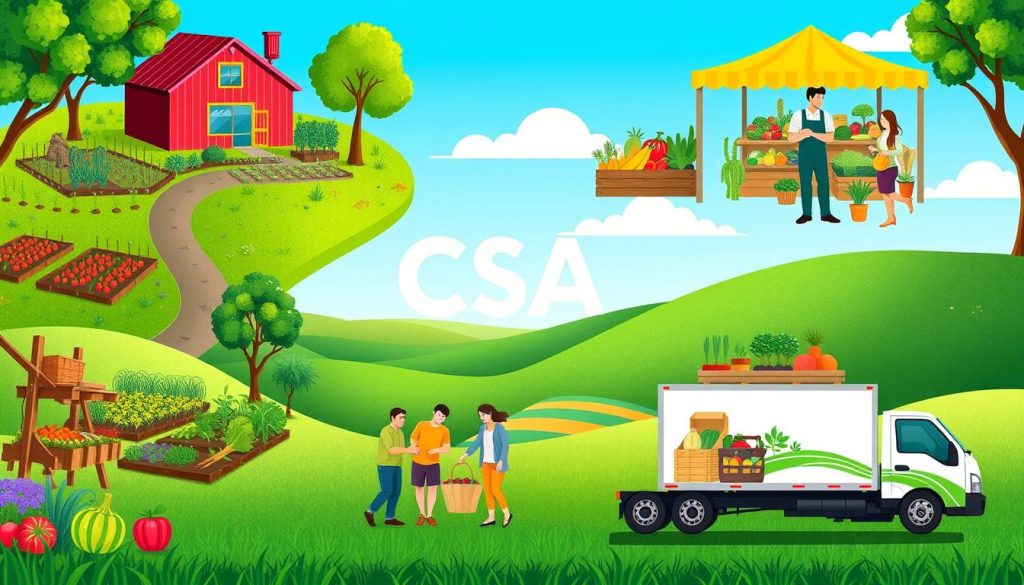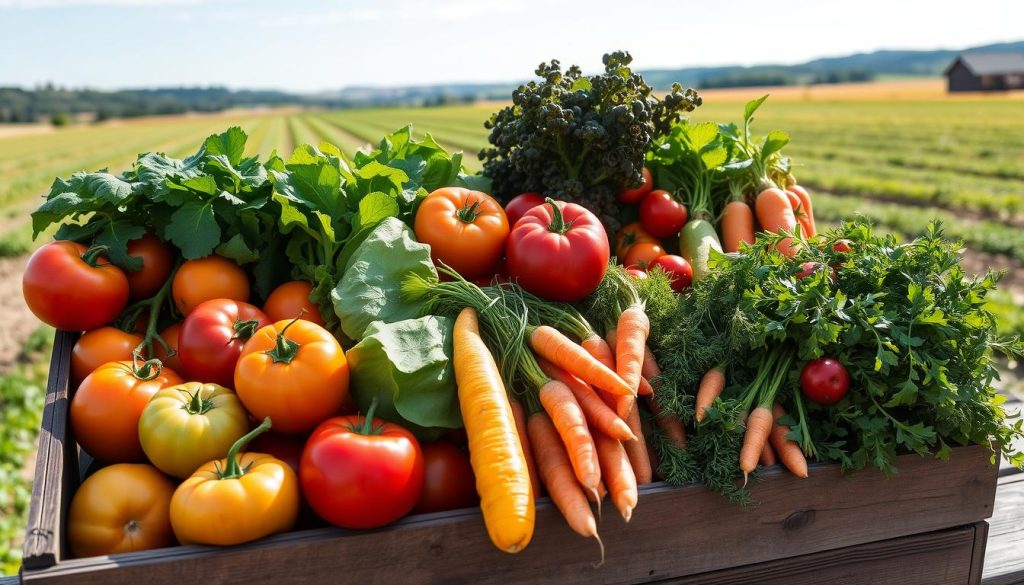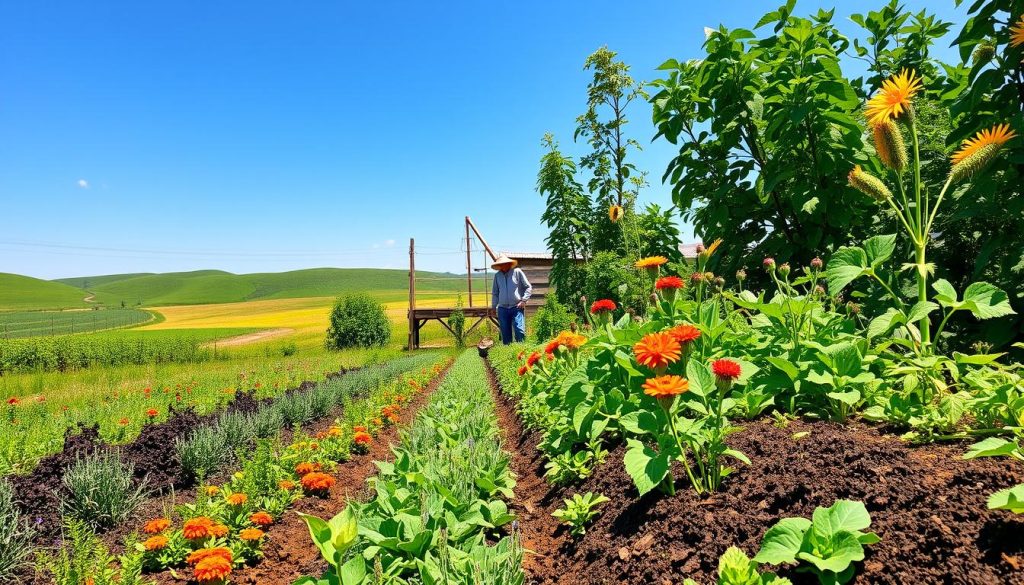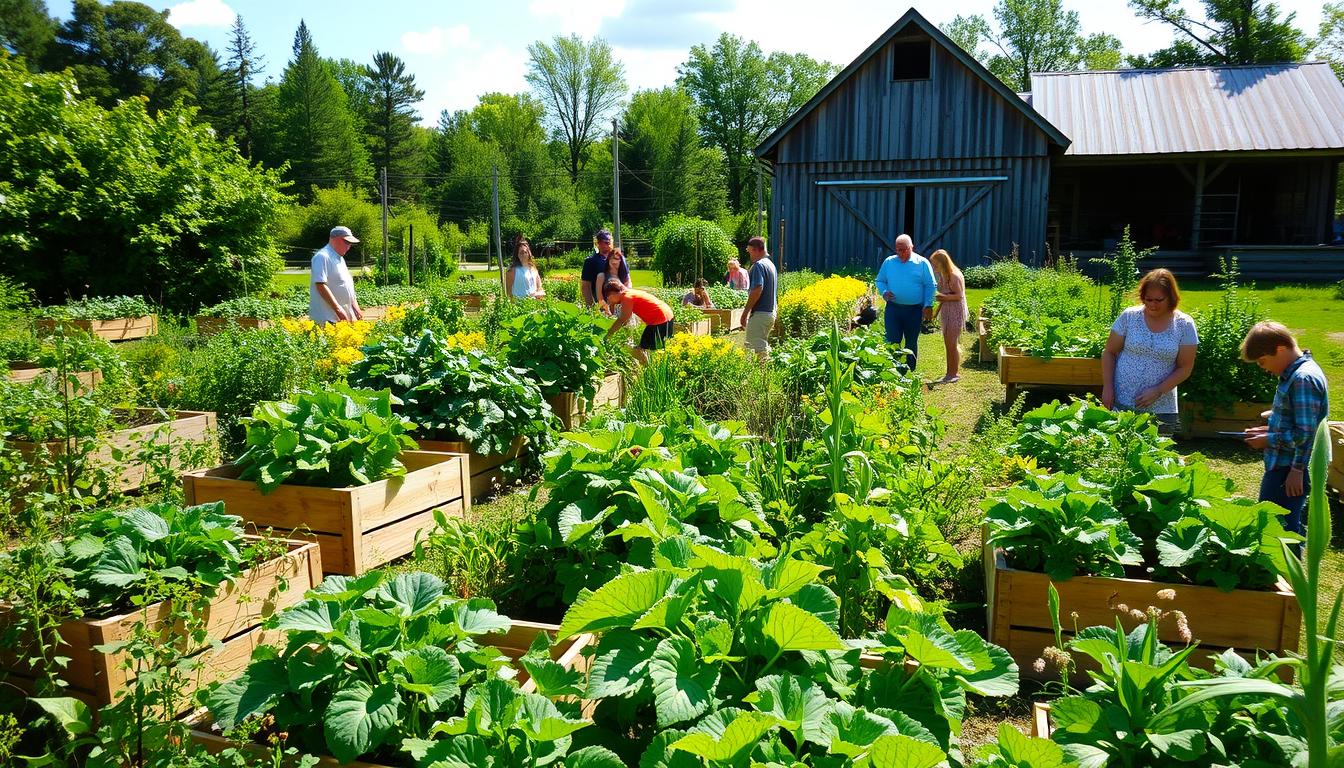I’m excited to share with you the world of Sustainable Community-supported Agriculture (CSA). CSA connects us directly with farmers. This way, we get fresh, high-quality produce and help small, organic farms thrive.
In this guide, we’ll explore CSA’s key principles and its many benefits. I’ll also give you tips on how to pick and join a CSA program that fits your values and needs. Whether you’re already into local food or new to CSA, this guide will help you make smart choices. It will also make you a part of the local food systems and organic farming practices movement.
What is Community-supported Agriculture (CSA)?
Community-supported Agriculture (CSA) is a special way for farmers and consumers to work together. It lets people support local farms and get fresh, quality food. When you join a CSA, you become part of a farm, getting a box of seasonal fruits and veggies every week or two.
Overview of CSA
The idea of CSA started in the 1960s. It became more popular as the farm-to-table movement grew. Farmers and consumers share the ups and downs of growing food, helping the environment and building community.
Key Principles of CSA
- Direct partnership between farmers and consumers
- Commitment to supporting local agriculture and sustainable farming practices
- Shared responsibility for the harvest, including the risks and rewards
- Emphasis on seasonal, locally-grown produce and the farm-to-table experience
- Fostering of community engagement and a sense of connection to the land
Joining a CSA means you get fresh, healthy food. You also help take care of the environment and build community, which are key parts of CSA.
Benefits of Participating in a CSA
Joining a Community-Supported Agriculture (CSA) program has many benefits. It’s not just about getting fresh, quality produce. As a member, I help local farmers and support our community’s food systems.
Freshness and Quality of Produce
CSAs let me enjoy a variety of fresh, seasonal produce. The crops are picked at their best and delivered to me. This means I get the best taste and nutrition.
Unlike store-bought produce, which may travel far, my CSA produce is always fresh. It’s the best choice for flavor and nutrition.
Supporting Local Farmers
Being part of a CSA means I support local farmers. This helps them keep their farms running and ensures our community has food. It’s a way to invest in sustainable farming for the future.
Economic Sustainability
CSAs are key to local economic health. By subscribing, I give farmers a steady income. This helps them stay afloat and keep producing quality food.
With a stable income, farmers can focus on better farming methods. They can also keep providing us with fresh, seasonal produce.
How to Choose the Right CSA Program

Choosing the right CSA program is key for sustainable Community-supported agriculture. I’m passionate about organic farming and community engagement. There are important factors to consider when picking a CSA that fits your values and needs.
Factors to Consider
First, think about the produce you like and any dietary needs. CSAs offer a wide range of fruits, veggies, and sometimes eggs, dairy, or meat. It’s vital to find one that matches your taste preferences.
Consider the size and how often you get your CSA share. Some CSAs deliver weekly, others bi-weekly or monthly. The share size also varies, so pick one that suits your household’s needs.
Questions to Ask Your CSA
When looking at CSA programs, ask lots of questions. Learn about their farming practices, like organic or sustainable methods. Also, ask about their community engagement and educational opportunities for members.
Different Types of CSA Models
- Traditional CSA: Typically a weekly or bi-weekly box of produce delivered to a central pickup location.
- Market-style CSA: Allows members to choose their own produce from a selection at a designated pickup site.
- Customizable CSA: Offers the ability to customize the contents of your CSA box, often with the option to add on additional items.
By considering these factors and asking the right questions, you can find a CSA program. It should provide fresh, high-quality produce and match your commitment to sustainable community-supported agriculture.
How to Get Involved with a CSA

Joining a community-supported agriculture (CSA) program is a great way to connect with your local food system. You’ll get to enjoy fresh, seasonal produce. The sign-up process might seem tough at first, but with some prep, you’ll soon enjoy the fruits of your local farms.
Signing Up and Membership Options
Start by looking for CSA programs in your area. Farms and organizations offer different CSA memberships. Some require a full season, while others are more flexible, like bi-weekly or monthly deliveries. Choose the membership that fits your family’s needs and budget.
What to Expect in Your First Season
- Variety of seasonal produce: Get ready to find new fruits and veggies all season.
- Flexibility and community engagement: You might visit the farm, volunteer, or join events. This deepens your connection to local food.
- Recipe inspiration: Cooking with seasonal produce is fun. Try new recipes that show off your CSA box’s flavors.
Joining a CSA is a great way to support your community and enjoy fresh produce. With some prep and an open mind, your first CSA season will be rewarding and enjoyable.
The Role of Sustainability in CSA

I’m excited to talk about how Community-Supported Agriculture (CSA) supports the environment. CSA focuses on local, regenerative farming. This helps reduce our harm to the planet.
Environmental Impact of Local Farming
Joining a CSA has big environmental benefits. It cuts down on the need for long-distance food transport. This saves resources and supports local farming.
It also helps keep our local ecosystems healthy. This is great for the environment and for us.
How CSA Supports Biodiversity
CSA programs do more than just help the environment. They also protect biodiversity. By using methods like crop rotation, they keep soil healthy.
This approach lets different plants and animals thrive. It makes our food fresh and our planet healthier.
Exploring CSA has shown me how it connects us to the land. By choosing local, sustainable food, we help our communities and the planet. It’s a fulfilling way to care for our environment.
Meal Planning with CSA Produce
Being part of a Community-supported Agriculture (CSA) program means you get fresh produce all year. These ingredients are key to making tasty, healthy meals. They help you join the farm-to-table movement and improve food security. But, how do you use your CSA box best? Let’s look at some seasonal recipes and tips to enjoy your local harvest.
Seasonal Recipes to Try
CSA programs let you try new, exciting foods. Here are some seasonal recipe ideas:
- In spring, make a vibrant asparagus quiche or a refreshing strawberry salad.
- Summer is perfect for a classic caprese salad or a hearty ratatouille with tomatoes.
- Autumn is great for roasting root vegetables or making a butternut squash soup.
- Winter calls for a comforting potato and kale stew or a baked apple dessert.
Tips for Preserving Fresh Produce
To cut down on waste and keep your produce fresh, try these methods:
- Blanch and freeze greens, berries, and other delicate items for later.
- Pickle or ferment veggies like cucumbers, carrots, and onions for year-round enjoyment.
- Dry herbs, tomatoes, and mushrooms to add flavor to your dishes.
- Can or dehydrate fruits and veggies to make pantry staples.
By using your CSA produce seasonally and preserving it, you can enjoy fresh flavors all year. This also helps your community’s food security.
Challenges and Considerations in CSA
Joining a Sustainable Community-supported agriculture (CSA) program is rewarding but comes with challenges. As a member, you’ll face risks and rewards. This is part of supporting local food systems and caring for the environment.
Understanding Risk and Reward
CSA is based on shared risk and reward between farmers and consumers. A bad harvest can affect your weekly share. Yet, this uncertainty makes you appreciate farmers’ hard work and sustainable farming’s strength.
Navigating Seasonal Changes
CSA produce changes with the seasons. You’ll get different fruits and veggies as the year goes on. This can be exciting but also a challenge, as you’ll try new foods and recipes.
Knowing the risks and rewards of CSA helps you enjoy supporting local food and the environment. Being ready for seasonal changes makes the experience even better.
Future of Community-supported Agriculture
The demand for local, sustainable food is growing fast. This makes the future of Community-supported Agriculture (CSA) look bright. I’m excited to see new trends that are changing this important model.
Growing Trends in CSA
There’s a big focus on food security and regenerative agriculture now. More people see how CSA helps get fresh, healthy food to everyone. Especially in areas that need it most.
By supporting local farmers who use sustainable methods, CSA is leading the way. It’s helping create a better food system for everyone.
How Technology is Shaping CSA Models
Technology is changing CSA for the better. It’s making it easier and more accessible than before. Online platforms and mobile apps are helping farmers and members connect better.
These digital tools are helping CSA reach more people. I’m looking forward to seeing how new ways of delivering food will meet the needs of today’s consumers.

